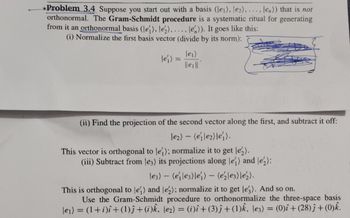
Advanced Engineering Mathematics
10th Edition
ISBN: 9780470458365
Author: Erwin Kreyszig
Publisher: Wiley, John & Sons, Incorporated
expand_more
expand_more
format_list_bulleted
Question

Transcribed Image Text:*Problem 3.4 Suppose you start out with a basis (le1), le₂),..., len)) that is not
orthonormal. The Gram-Schmidt procedure is a systematic ritual for generating
from it an orthonormal basis (le), le₂),..., len)). It goes like this:
(i) Normalize the first basis vector (divide by its norm):
le₁) =
le₁)
lleill
(ii) Find the projection of the second vector along the first, and subtract it off:
le₂) - (eile₂) lei).
This vector is orthogonal to le); normalize it to get le₂).
(iii) Subtract from e3) its projections along le) and le₂):
les) - (ejles) lej) - (e₂|e3)|e2).
This is orthogonal to le) and le2); normalize it to get leg). And so on.
Use the Gram-Schmidt procedure to orthonormalize the three-space basis
|e₁) = (1 + i)î+ (1)ĵ+ (i)k, \e₂) = (i)î+ (3)ĵ+(1)k, |e3) = (0)î+ (28) ĵ + (0)k.
Expert Solution
This question has been solved!
Explore an expertly crafted, step-by-step solution for a thorough understanding of key concepts.
This is a popular solution
Trending nowThis is a popular solution!
Step by stepSolved in 2 steps with 2 images

Knowledge Booster
Similar questions
- 3. Given a₁ = (1,1,1,1), a₂ = (1,-1,0,4), a3 = (3,5,1,-1), use the Gram-Schmidt process to obtain an orthonormal vector set.arrow_forward9. Consider the orthonormal basis S for R' S = {v₁,v₂,v,} where v₁ = (0,1,0) S= v, -(-3.0,) and v, - (3.0.3). Let u = (1,0,4). Find (2), = 8 19 A (u), -(0,-3,1) = 8 19 B (u), - (1,3,7) = 8 19 C (u), = (0,3, 1/2) D No correct answer E (u) = (0,8,19)arrow_forward(i) Give an example of two orthonormal vectors in R³. (ii) Using C=9 D=3 E=5 F=4 Schmidt process to find an orthonormal basis from the initial vectors () and (7). use the Gram- (iii) Construct a matrix which implements a shear of factor 3 along the first vector of your basis constructed in (ii), in that basis. Then use change of basis methods to give the corresponding (similar) matrix in the standard basis of R². Homeworkarrow_forward
- A certain radioactive substance has a half-life of 3.6 years. Find how long it takes (in years) for the substance to decompose to 10% of its initial amount.arrow_forwardanswer for parts b and carrow_forwardUse the dot method to add the numbers below. If the number needs a dot, put a dot (period) to the right of the number. Otherwise leave it blank.arrow_forward
- Please can you help me with these two questions. I got it them both wrongarrow_forwardFind the coordinate vector of u relative to the given orthonormal basis B. {(늘를 글) (금 1 2 2 2 2 1 2 1 2 и %3D (2, 4, 5); в — 3'3' 3 3 3'3 3' 3' 3 UB IIarrow_forward[-1/5] 2/ 5 [2/V5] [1//5] Q9) Let u,= ,AU2= Show that {u1,u,} is an orthonormal basis for R².arrow_forward
arrow_back_ios
arrow_forward_ios
Recommended textbooks for you
 Advanced Engineering MathematicsAdvanced MathISBN:9780470458365Author:Erwin KreyszigPublisher:Wiley, John & Sons, Incorporated
Advanced Engineering MathematicsAdvanced MathISBN:9780470458365Author:Erwin KreyszigPublisher:Wiley, John & Sons, Incorporated Numerical Methods for EngineersAdvanced MathISBN:9780073397924Author:Steven C. Chapra Dr., Raymond P. CanalePublisher:McGraw-Hill Education
Numerical Methods for EngineersAdvanced MathISBN:9780073397924Author:Steven C. Chapra Dr., Raymond P. CanalePublisher:McGraw-Hill Education Introductory Mathematics for Engineering Applicat...Advanced MathISBN:9781118141809Author:Nathan KlingbeilPublisher:WILEY
Introductory Mathematics for Engineering Applicat...Advanced MathISBN:9781118141809Author:Nathan KlingbeilPublisher:WILEY Mathematics For Machine TechnologyAdvanced MathISBN:9781337798310Author:Peterson, John.Publisher:Cengage Learning,
Mathematics For Machine TechnologyAdvanced MathISBN:9781337798310Author:Peterson, John.Publisher:Cengage Learning,


Advanced Engineering Mathematics
Advanced Math
ISBN:9780470458365
Author:Erwin Kreyszig
Publisher:Wiley, John & Sons, Incorporated

Numerical Methods for Engineers
Advanced Math
ISBN:9780073397924
Author:Steven C. Chapra Dr., Raymond P. Canale
Publisher:McGraw-Hill Education

Introductory Mathematics for Engineering Applicat...
Advanced Math
ISBN:9781118141809
Author:Nathan Klingbeil
Publisher:WILEY

Mathematics For Machine Technology
Advanced Math
ISBN:9781337798310
Author:Peterson, John.
Publisher:Cengage Learning,

